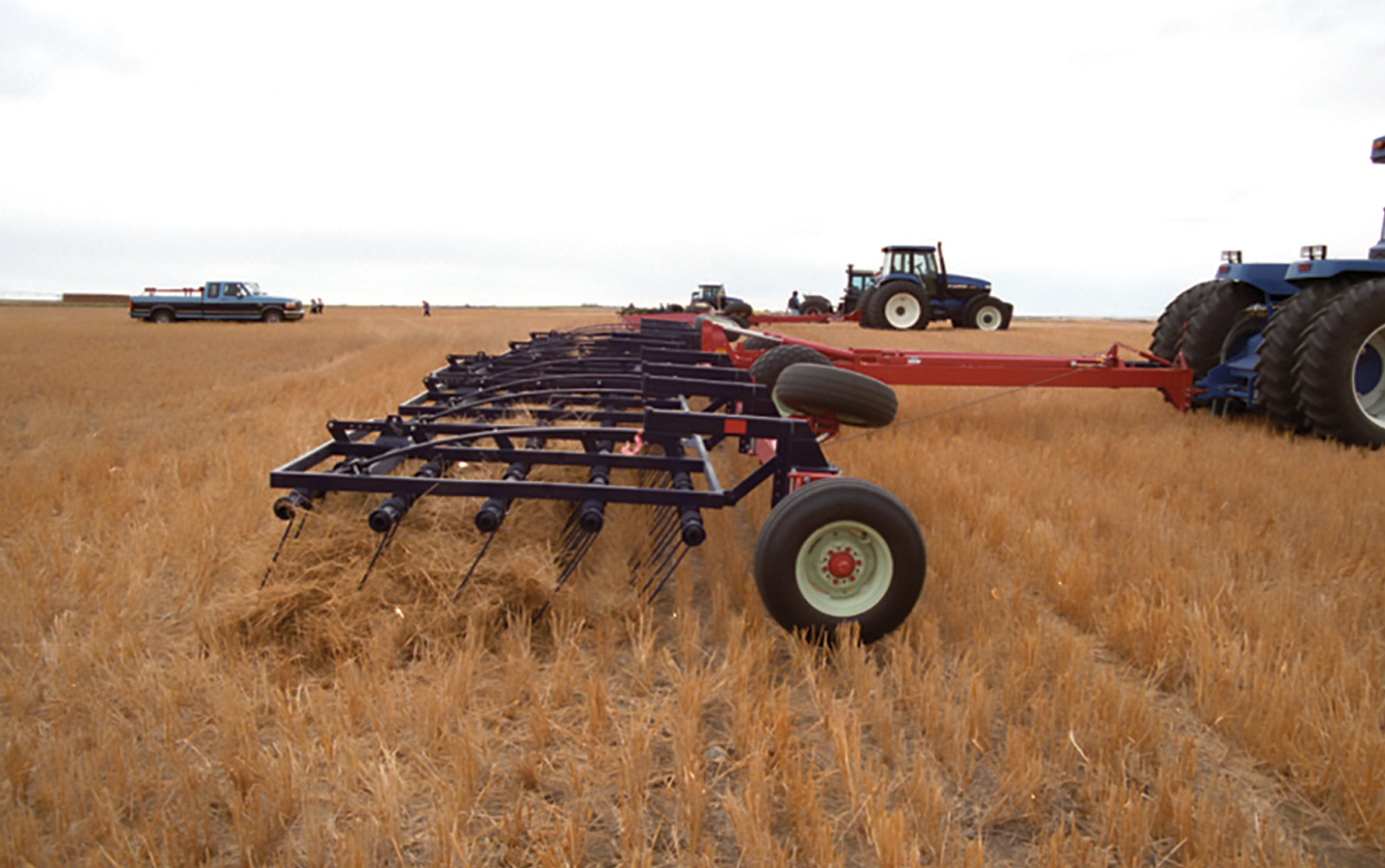Management options for heavy residue
An effective residue-management system must consider timeliness, economics, cropping plans and conservation of soil and soil moisture. It must also leave the field surface in suitable condition for seeding equipment to place the seed at the proper depth with good seed-to-soil contact.
The list describes various residue-management options, including tips on how to manage crop that overwintered unharvested – a situation many Prairie farmers experienced this past winter.
1. The combine
The combine’s straw chopper and chaff spreader are the best tools for residue management. Most manufacturers supply after-market attachments to improve chop and spread performance, if necessary.
2. Seeding systems
Farmers can upgrade existing equipment to improve seed placement in high-residue situations. For example, residue managers, which consist of tines, spikes, notched discs or grooved rubber, can pull, move, throw or pin-and-cut residue in front of seeding opener systems. Row spacing between openers and the type of residue manager will significantly vary the residue clearance. Coulters have been designed to cut residue in front of seeding openers, reducing residue wrapping around shanks or between disks. Disc openers typically clear higher amounts of standing residue than hoe- and shank-type openers can. However, discs have poorer soil penetration and seed placement when high amounts of residue are on the soil surface or in piles.
3. Conventional Tillage
A cultivator will help break up piles and spread them out, but will not incorporate quickly and may require several passes. A discer will cut, break up and incorporate residue quicker than cultivation, but will not spread out piles as quickly and would likely require more than one pass. Tillage is generally done at a two- to four-inch depth for best operation and any amount of tillage reduces soil quality and structure and increases greenhouse gas emissions.
4. Harrowing
Lighter tined-type harrows could be used in conjunction with cultivation to increase residue break up and spreading, thus reducing the passes of cultivation alone. Light harrowing alone can spread residue and results in low soil disturbance, but is not as effective in heavy residue. Rotary harrows are more aggressive and can break up and spread straw quickly, but do create some soil disturbance. Rotary harrows can roll over excessive residue and piles to reduce plugging, but for this reason are not as effective to spread excessive residue concentrations. Heavy harrows are very aggressive and will handle high residue concentrations, but will also create some surface soil disturbance.
5. Capturing residue for feed
Residue dropped behind the combine can be baled. High-moisture residue can be baled and then wrapped for long-term storage. Some farms also collect residue in wagons behind the combine and stack it for feed. These are effective ways to manage heavy residue, but they remove more nutrients that have to be replaced through fertilization. (See Table 1.)
| Crop straw and chaff | lb N/ton | lb P2O5/ton | lb K2O/ton | lb S/ton | Total $/ton** |
|---|---|---|---|---|---|
| Wheat | 30 | 8.3 | 54 | 6.4 | 63.04 |
| Barley | 35 | 10.1 | 77 | 6.4 | 79.63 |
| Oats | 34 | 8.7 | 79 | 7.4 | 78.19 |
| Peas | 58 | 15.2 | 54 | 10 | 99.12 |
* straw with 10 per cent moisture
** based on fertilizer prices of $0.99/lb N; $1.10/lb P2O5; $0.42/lb K2O; and $0.24/lb S.
6. Vertical tillage or multi-tool
Specialized tools with combinations of harrows, concave disks, coulters and/or shanks can be used to till, break up and spread heavy amounts of residue. Each design has a combination of any two, or possibly all, of the above-mentioned tools mounted on one large frame. They can be very effective at residue management, but they require high horsepower and create high surface-soil disturbance. Research has not looked into long-term effects from using this equipment.
7. Mowing
Large heavy-duty mowers have
been designed for hard, thick and heavy residue.
8. Grazing
One method of livestock winter feeding is to leave residue piles or windrows in the field, then use temporary fencing to move livestock through the field.
and search for “com16303”.
Factors that affect residue management
- Higher moisture residue will not cut, break, chop or spread as well as dry residue.
- High soil moisture will reduce the effectiveness of tillage and make the residue tougher.
- Cereal residue is not the same as canola residue or pulse residue, for example. Each will require different levels of management to reach the same processed level.
- Amount of residue will significantly impact how any practice will work. With 75 per cent or more residue cover (such as with unharvested crop), effectiveness of most residue-management equipment will be significantly reduced.
- Research has shown that if the average length of residue is more than 70 per cent of the tool spacing, plugging will occur. Most research has shown that if the average residue height is more than 65 per cent of the equipment clearance, plugging will likely occur. With the seeding tool, opener spacing, equipment height clearance, number of rows and opener design will all influence the residue clearance capability.





